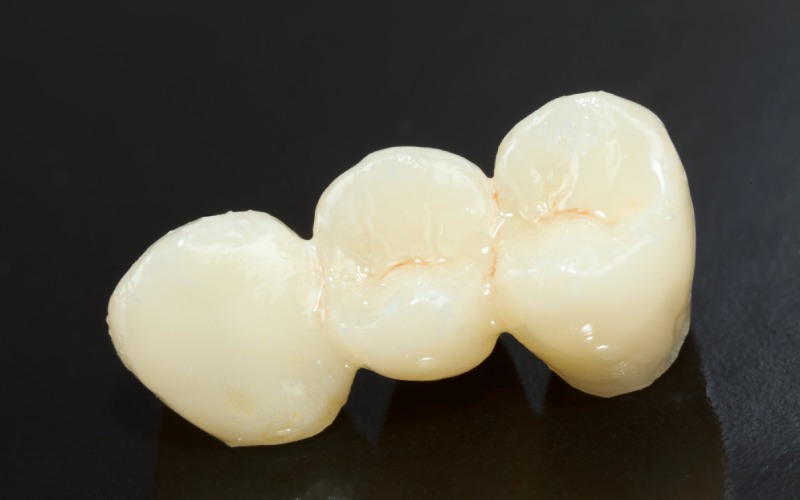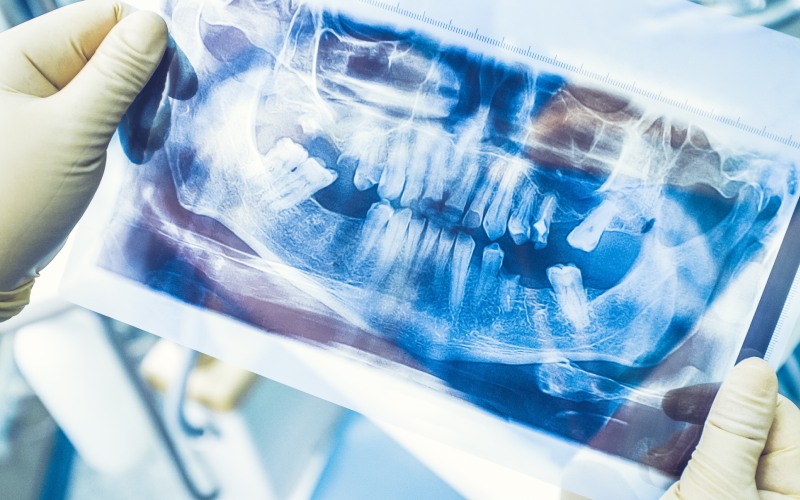Dental bridges are a common, non-removable prosthetic device designed to literally ‘bridge’ the gap created by one or more missing teeth. Not only do they restore your smile, but they also offer improved oral health.
There’s a variety of dental bridges available, each with unique advantages. From traditional bridges anchored by crowns, to innovative implant-supported bridges, the options are vast.
Table of Contents
ToggleUnderstanding Dental Bridges
Definition of Dental Bridge
A dental bridge functions as you’d expect from its name. It forms a “bridge” in your mouth. Think of it as a construction project occurring in your oral cavity. But what exactly creates this bridge?
Primarily, it has three components: pontics, abutment teeth, and dental crowns. Each part plays a vital role in the construction. Pontics serve as the new tenants, replacing missing teeth. They are artfully crafted from porcelain or metal, sometimes a fusion of both to create a natural appearance. Abutment teeth, on the other hand, form the pillars of our dental bridge. These strong, healthy teeth adjacent to the gap act as the foundation or ‘anchors’. Finally, to fortify the construction, dental crowns overlay the abutment teeth, lending additional support and strength.
Importance of Dental Bridges
There’s more to dental bridges than just a functional fixture. Yes, they replace missing teeth, but can’t we manage without that tooth? Well, living with missing teeth isn’t without consequences.
With dental bridges, you restore functionality, something compromised by gaps in your teeth. Imagine being able to bite into your favourite food without hesitation or speak clearly and confidently in public. An added bonus—bridges enhance aesthetics, stealthily blending in and making your smile complete.
Adjacent teeth, uncaring of gaping vacancies, tend to wander into empty spaces. Dental bridges maintain discipline among your teeth by preventing such rebellious shifts, ensuring proper alignment.
Even time ticks in favour of dental bridges. They offer a quick solution when compared to other replacements such as implants. Bridges act as a conservative option giving your damaged teeth an undercover cloak of respectability. By becoming a part of the bridge, these teeth avoid further extensive procedures.

Different Types of Dental Bridges
Understanding the diverse types of dental bridges is crucial, especially considering they cater to different needs and conditions. Each of these types has unique advantages that make them suitable for specific situations.
Traditional Dental Bridges
Traditional Dental Bridges are often utilized, making them the most common type of dental bridge. This type comprises one or more pontics (fake teeth) which are held securely by dental crowns. These crowns are cemented on the adjacent or ‘abutment’ teeth. Often recommended when you’ve got healthy teeth on both sides of the gap, these bridges offer strength capable of withstanding biting and chewing forces. But, accommodating these crowns involves the removal of enamel from the abutment teeth, an important point to take into account when considering this option.
Cantilever Dental Bridges
Cantilever Dental Bridges differ slightly. They’re uniquely designed for when there are teeth on just one side of the missing tooth gap. In this case, the pontic is supported by a dental crown cemented on a single abutment tooth. While this arrangement puts extra pressure on the abutment tooth, Cantilever bridges are a viable option if the biting pressure is on the lower side, as with front teeth.
Maryland Dental Bridges
In contrast, Maryland Dental Bridges, also referred to as resin-bonded bridges, use a different technique to support the pontic. The pontic in this case is attached to a metal or porcelain framework. This framework is bonded onto the rear side of the abutment teeth. A major advantage here is the adjacent teeth don’t need to be prepared as with traditional and cantilever bridges, preserving your natural tooth structure. But, the strength of these bridges depends on the bonding with the abutment teeth, making them less favourable for areas of high biting stress.
Implant-Supported Dental Bridges
Finally, Implant-Supported Dental Bridges offer an option that doesn’t rely on crowns or frameworks. Instead, they use dental implants to support the pontic, usually with an implant for each missing tooth. These tend to offer a more robust and lasting structure, as the bridge is securely anchored by the implants. In this scenario, consider that dental surgery is involved, hence ensuring optimal oral health is crucial before opting for this bridge type.
Benefits of Dental Bridges
Having explained the prevalent types of dental bridges, let’s now investigate the manifold benefits that dental bridges bring to the table. Beyond merely replacing the teeth, they enhance self-confidence, improve oral functionalities, help prevent numerous dental issues, and play a pivotal role in the preservation of your facial structure.
Improved Oral Functionality
Don’t you miss savouring corn on the cob or biting into a crunchy apple unimpeded by missing teeth? Fortunately, dental bridges restore such simple pleasures, thanks to the improved functionality they offer. They replace missing teeth, enabling you to eat a diverse range of foods and speak normally, as there’s no longer a gap interfering with the movement of your tongue and jaw.
Prevention of Dental Issues
A missing tooth sets off a domino effect of dental issues if unaddressed. The surrounding teeth may shift to fill the gap, leading to potential misalignment and bite problems. Dental bridges forestall such outcomes by holding the neighboring teeth in place. Besides, they help keep gum diseases and tooth decay – often resulting from gaps – at bay.
Preservation of Facial Structure
Ever noticed how some people’s faces tend to look sunken and prematurely aged due to missing teeth? That’s because the absence of teeth over time can lead to jawbone deterioration. Introduce dental bridges into this scenario, and they maintain the shape of your face by preventing bone loss.

Procedure of Getting a Dental Bridge
Initial Consultation
The initial consultation sets the tone for the entire procedure. Your dentist will conduct a thorough examination of your oral health, taking into consideration the stability of your remaining teeth and the condition of your gums. Depending on the state of your teeth, X-rays may be taken to assess the bone structure. This comprehensive approach ensures that the best type of dental bridge for your specific needs is identified. You’ll also have the opportunity to discuss the various bridge options available, making sure your concerns are addressed and that the decision you make is well-informed.
Tooth Preparation
Next, comes the tooth preparation stage. If you’ve chosen a Traditional or Cantilever bridge, your dentist will prepare the abutment teeth by removing some enamel. This is an irreversible process designed to create room for the crowns that will support the bridge. But, in the case of a Maryland bridge, minimal enamel reduction is required, with only a mild etching on the back of adjacent teeth for effective bonding.
Temporary Bridge Placement
After your teeth have been prepared to accommodate your bridge, a mould of the affected area is usually taken. This mold serves as a guide for the custom crafting of your dental bridge, ensuring a perfect fit. In the meantime, a temporary bridge may be placed to protect the prepared teeth and maintain functionality.
Bridge Fabrication
Bridge fabrication happens primarily off-site in a dental lab. Using the mould taken during tooth preparation, technicians craft a bridge that not only fits your mouth perfectly but also colour matches your existing teeth for a natural appearance. Whether the bridge is crafted from porcelain, ceramics, or metal alloys, it is designed to withstand the forces of biting and chewing.
Final Bridge Placement
Finally, the final bridge placement takes place. The moment you’ve been waiting for! Your dentist will place the bridge, checking the fitting and making the necessary adjustments. Once it’s confirmed to fit correctly, the bridge is fixed permanently onto your abutment teeth. This can be achieved through cementation or the use of small screws.
Risks and Disadvantages of Dental Bridges
Just as dental bridges resolve missing teeth issues, they present their potential drawbacks and hazards. Future damage to the supporting—abutment—teeth, may jeopardize the bridge. Bacteria and plaque may infiltrate an ill-fitting bridge or crown, triggering tooth decay. Changing your tooth’s structure through crowning, may alter your bite. If the abutment teeth lack strength for support, the bridge may collapse. Also, the procedures might weaken abutment teeth, leading to their replacement by dental implants.
On a procedural note, securing a dental bridge may call for a minimum of two dentist visits, stretching over a substantial span of time. But, a Maryland bridge mandates fewer appointments than its counterparts, as the abutment teeth need not be prepared.
The lifespan of dental bridges spans between 5-15 years before a replacement becomes necessary. By ensuring proper care, you can amplify its durability. Routine cleaning is essential to avert the risk of tooth decay and gum disease. The choice of the best bridge type relies on factors like the gap size, the health state of surrounding teeth, and cost considerations. It’s crucial to remember although beneficial, getting dental bridges can be a potentially painful experience.
Choosing the Right Dental Bridge: Guidance from Onyx Dental in Mississauga
Understanding dental bridges is crucial for making an informed decision about your oral health care. You’ve explored the various types—Traditional, Cantilever, Maryland, and Implant-Supported bridges—each offering distinct advantages. You’re now familiar with the entire process, from the initial consultation to the final placement, as well as the potential risks involved. You’ve also learned about the importance of proper care for your dental bridge to ensure its durability. Choosing the right type of bridge will depend on several factors, which should be thoroughly discussed with your dentist. While the process may entail some discomfort and require multiple visits, the outcome is a rejuvenated smile that enhances your oral functionality. Onyx Dental in Mississauga provides these restorative dental services, helping you take the next step towards a healthier smile.



